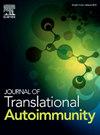调节性T细胞治疗Sjögren病:从发病机制到靶向治疗
IF 3.6
Q2 IMMUNOLOGY
引用次数: 0
摘要
Sjögren病(SjD)是一种慢性系统性自身免疫性疾病,其特征是淋巴细胞浸润涎腺和泪腺,导致干眼和口干的标志性症状。除了腺体功能障碍外,许多患者还会出现全身性并发症,包括B细胞过度活跃、器官特异性炎症和非霍奇金淋巴瘤的风险显著增加,这些并发症往往未被充分认识和管理不善。目前的治疗仍然主要是经验性和对症治疗,在改变疾病进展或恢复免疫耐受方面疗效有限。最近的进展揭示了先天免疫和适应性免疫的深刻失调,揭示了临床试验中正在研究的新的治疗靶点,包括I型干扰素信号传导、B细胞激活和共刺激途径。这种失调的核心是T细胞驱动的病理:CD8+ T细胞的细胞毒性、有缺陷的调节性T细胞(Treg)功能和HLA ii类介导的自身抗原向自身反应性CD4+ T细胞的呈递是疾病发生和持续的关键机制。越来越多的证据表明,Ro自身抗原ro60和ro52是SjD发病机制的中心靶点。大约70%的患者存在抗ro抗体,并作为诊断标记和全身累及的指标。Ro抗原及其相应的抗体在发炎的唾液组织中一直被检测到,强调了它们作为抗原特异性治疗的引人注目的靶点的潜力。本文综述了ro特异性T细胞反应在SjD中的免疫致病作用,并概述了基于treg的工程化治疗如何能够实现精确的免疫调节,恢复耐受性,并为患有这种复杂自身免疫性疾病的患者提供持久的疾病控制。本文章由计算机程序翻译,如有差异,请以英文原文为准。
Regulatory T cell therapy for Sjögren's disease: From pathogenesis to targeted treatment
Sjögren's disease (SjD) is a chronic systemic autoimmune disorder characterised by lymphocytic infiltration of the salivary and lacrimal glands, leading to the hallmark symptoms of dry eyes and dry mouth. Beyond glandular dysfunction, many patients experience systemic complications—including B cell hyperactivity, organ-specific inflammation, and a markedly increased risk of non-Hodgkin lymphoma—that are frequently under-recognised and poorly managed. Current treatments remain largely empirical and symptomatic, with limited efficacy in modifying disease progression or restoring immune tolerance.
Recent advances have illuminated profound dysregulation in both innate and adaptive immunity, revealing novel therapeutic targets now under investigation in clinical trials, including type I interferon signalling, B cell activation, and co-stimulatory pathways. Central to this dysregulation is T cell–driven pathology: CD8+ T cell cytotoxicity, defective regulatory T cell (Treg) function, and HLA class II–mediated presentation of self-antigens to autoreactive CD4+ T cells are key mechanisms in disease initiation and persistence.
A growing body of evidence implicates Ro autoantigens—Ro60 and Ro52—as central targets in SjD pathogenesis. Anti-Ro antibodies are present in approximately 70 % of patients and serve as both diagnostic markers and indicators of systemic involvement. Ro antigens and their corresponding antibodies are consistently detected in inflamed salivary tissues, underscoring their potential as compelling targets for antigen-specific therapy.
This review examines the immunopathogenic role of Ro-specific T cell responses in SjD and outlines how engineered Treg-based therapies may enable precise immune modulation, restore tolerance, and provide durable disease control for patients with this complex autoimmune condition.
求助全文
通过发布文献求助,成功后即可免费获取论文全文。
去求助
来源期刊

Journal of Translational Autoimmunity
Medicine-Immunology and Allergy
CiteScore
7.80
自引率
2.60%
发文量
33
审稿时长
55 days
 求助内容:
求助内容: 应助结果提醒方式:
应助结果提醒方式:


